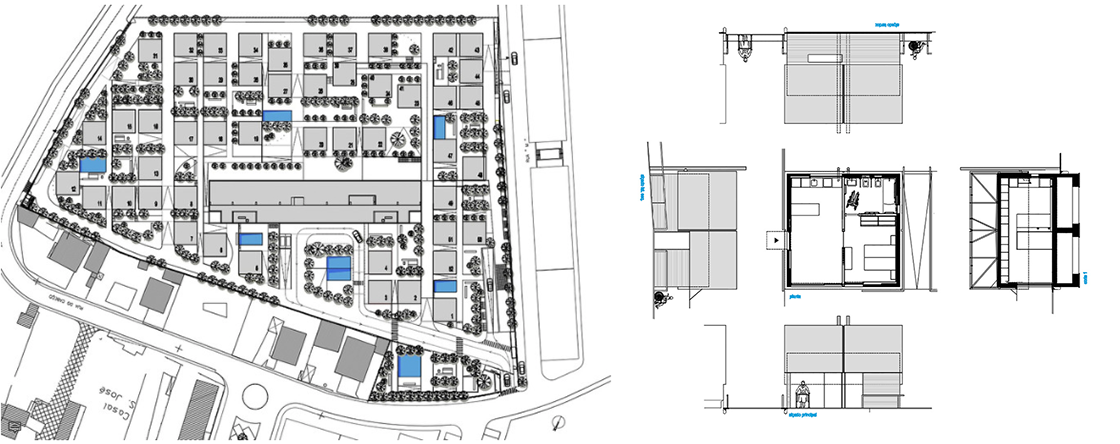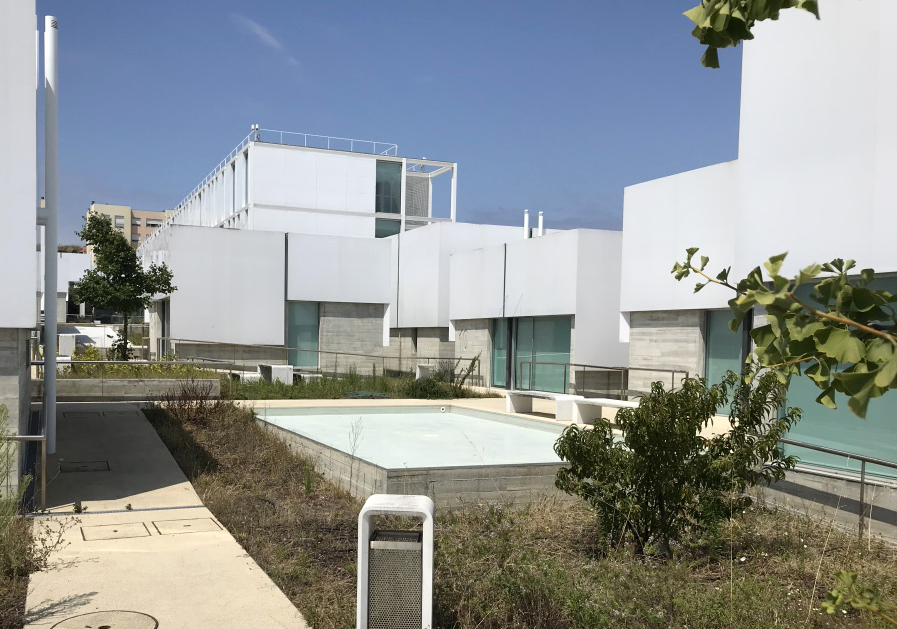
Housing complex in Alcabideche, Portugal, Part 2. Housing has always been key to modern architecture in Europe, and interestingly, remains a relevant topic throughout the old continent today. I visited some of the most seminal works by Portuguese architects who have tackled this topic with fervor and commitment.
Of course, much of my attention was given to the 1992 Pritzker Prize winner Alvaro Siza, father figure of the movement referred to as the School of Porto. While I was a student in Switzerland in the early 80’s, Siza was part of a list of important up-and-coming international architects teaching at the Ecole Polytechnique Féderale de Lausanne (EPFL). I will admit that at that time, I failed to understand the magnitude of Siza’s social impact, but am delighted to have now—after far too many years—confirmed in person my admiration towards his art of building.
Both modest and majestic, formally complex and humble in its expression, Siza’s architecture retains such beauty and poetry—this despite the severity and simplicity of many of the spaces. In particular, I wanted to see his 1974-1977 SAAL S. Victor Housing in Porto, which “is one of Siza’s most politically engaged works.” With this project. and other subsequent commissions, Siza marked generations of students who contributed to Portugal becoming a center of architectural distinction.
Fast forward a year later during a second trip to Portugal, and I was adamant, regardless of schedule or distance, to visit the work of Guedes Cruz Arquitectoswhose café I had enjoyed the year before in Porto. In particular, I wanted to see the recently completed senior housing project in Alcabideche; a half hour car ride from downtown Lisbon, Portugal’s capital city. After several U-turns and requests for directions, I finally arrived at the Libervita Senior Residence complex located at 179 Rua das Camélias.

Needless to say, what a disappointment when I learned that the complex was closed to the general public, and this despite my student-like plea to be granted access to the site. Before arrival, I had the suspicion that I wouldn’t be allowed in, given the property’s function as a social complex for elderly people who need privacy and security. Therefore, with plan in hand I walked the periphery defined by a low enclosure wall and viewed the 50 plus individual villas and the centrally located three-story building which includes apartments, nursing and medical care, cleaning, meal preparation and dining facilities, medical and nursing support, as well as therapy.

Although I’m not an expert on programming for elderly living, I have observed retirement developments in the United States and find that typically there is a fundamental lack of interest in creating a place with overall spatial qualities, which bestow natural light and provide TRUE community spaces and places beyond the generic all-purpose gathering rooms.
The Alcabideche complex that “accommodate[s] seniors in situations of dependency and physical rehabilitation, as well as independent or with a slight dependence,” is far from what I have experienced and seems to promote common sense values, some of which I have outlined below.
- While it is designed as a self-contained community, the grid-like organization offers an atmosphere similar to city life with streets and avenues that vary in size and scale, interspersed with appropriate landscaping (soon to mature). Most importantly, the design creates a mix of intimate and larger plazas that provide a neighborhood life; a quality and sense of place that seniors in their earlier lives enjoyed as active citizens.
In addition, given the gentle topography of the site, the archi tects created a complex with modifications in the terrain that were easily negotiated via handicap accessible ramps, giving a sense that each pathway was for all residents, regardless of the lack of any physical impairments. The landscaping is varied and visually attractive and includes small lawns with public seating areas as well as private garden spaces next to many of the villas. There is a conscious attention to create a series of varied micro climates, a tradition based on the southern climate of Portugal.
tects created a complex with modifications in the terrain that were easily negotiated via handicap accessible ramps, giving a sense that each pathway was for all residents, regardless of the lack of any physical impairments. The landscaping is varied and visually attractive and includes small lawns with public seating areas as well as private garden spaces next to many of the villas. There is a conscious attention to create a series of varied micro climates, a tradition based on the southern climate of Portugal. - The scale of the one-story homes is modest and barrier free. The typical tripartite layout reflects a desire to integrate the outside with the inside and vice versa, accommodating living and dining spaces with a galley kitchen, and an adjacent bedroom and bathroom. A large window to the scale of the villa typically serves both the interior public spaces (living and dining) while extending partially into the bedroom.
- Finally, the restrained palette of materials is exposed reinforced concrete for the base, a concealed metal truss structure, and a frosted Plexiglas roof that folds down midway on all sides of the facades and serves at night as a “house lamp” at the scale of the city. (Interestingly, this “lamp” can be illuminated in red to call attention to the location of an emergency.)
I spent over an hour imagining how delightful it would be to live here and upon my return to Lisbon, I was reminded how much architecture continues to enhance human life through well calibrated interventions that include principles of architecture, urban design, landscape architecture, interior design, and industrial design. Both the Café Do Cais in Porto, and the Alcabideche complex designed by Guedes Cruz Arquitectos illustrated for me great restraint and a clear understanding of how to edit design while never rendering it banal.
I long to see a built environment espouse more persuasively those precepts by integrating multiple disciplines with humility, generosity, and above all with design intelligence. America’s architecture would be less about objects, and more about an integrative approach in experiencing our cities.
For additional images, visit Alcabideche